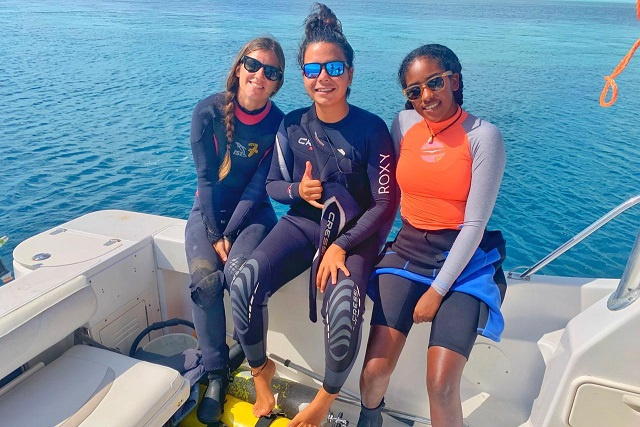All-women team of divers works to monitor health of Seychelles' coral

An all-women diver team from the Seychelles Island Foundation is currently conducting this year's monitoring in the Aldabra surrounding waters. (Seychelles Islands Foundation)
(Seychelles News Agency) - As Seychelles joins the rest of the world to celebrate International Women's Day, SNA spoke with a member of an all-women diver team from the Seychelles Island Foundation currently conducting this year's monitoring in the Aldabra surrounding waters.
A marine researcher from SIF and a member of the team, Anna Koester, told SNA that "it is great to work with an all-women dive team and to share the passion for the marine environment with likeminded women."
"It is a very encouraging and rewarding experience. There is a powerful team spirit that encourages everyone to take up new challenges and to learn from each other," said Koester.
Under the Aldabra Reef Monitoring (ARM) programme, every year SIF monitors a suite of hard corals, soft corals, other invertebrates, algae and various fish species in the waters of Aldabra.
 |
| Koester said it is great to work with an all-women dive team and to share the passion for the marine environment with likeminded women. (Seychelles Islands Foundation) Photo License: All Rights Reserved |
Koester said that rough weather and strong currents are the most common challenges encountered by the team, which can result in seasickness and difficult dives when currents are strong and there is a lot of swells.
On a typical day, the diver team goes out to conduct two to three monitoring dives, depending on the tidal window available.
"The diving team gets all the diving and research equipment ready, which includes transect tapes, PVC frames for the benthic photo quadrats and the coral juvenile quadrats, cameras, spare batteries, underwater torches and dive slates to record data underwater. The skipper and boat hand prepare the boat for the day and help the divers loading the boat. The time needed to reach the survey sites ranges between five to 60 minutes, depending on the location of the site and the weather conditions," said Koester.
She explained that once the divers descend to the start of the transect, the fish surveyors are the first to start where one diver swims ahead, conducting the fish counts whilst another diver follows behind and lays the transect tape.
 |
| On a typical day, the diver team goes out to conduct two to three monitoring dives, depending on the tidal window available. (Seychelles Islands Foundation) Photo License: All Rights Reserved |
"Following these are the benthic surveyors – one diver taking photos of the reef floor through the benthic photo quadrat frame while the other diver records juvenile corals. The benthic surveyors usually finish earlier than the fish surveyors and, if needed, download the temperature data from the underwater data loggers. A typical survey dive usually takes 45 to 55 minutes," she said.
Following a surface interval, the team moves to the next site to repeat the procedure. Once back at the station, the team unloads the boat, cleans the equipment and fills the SCUBA tanks used. Datasheets are stored and footage is saved for analysis later on.
Koester, told SNA that "this programme is important to understand changes to the coral reef ecosystem and its fish communities over time, specifically in relation to climate change induced coral bleaching events, the potential spread of invasive species and coral diseases."
"It also serves to measure if and how the subsistence fishing of SIF's research stations has an impact on Aldabra's fish communities," added Koester.
ARM was initiated in 2013, shortly before the last global coral bleaching event that affected Seychelles in December 2015 to June 2016, and hence has allowed the foundation to monitor the impact of the event on Aldabra's reefs.
 |
| Koester said this programme is important to understand changes to the coral reef ecosystem and its fish communities over time. (Seychelles Islands Foundation) Photo License: All Rights Reserved |
Koester said that following the bleaching event, SIF recorded 34 to 55 percent coral loss in different sites.
Corals found in the reefs inside the Aldabra lagoon have nearly completely recovered from the last global coral bleaching event of 2015 and 2016, whereas recovery of corals on the seaward reefs is slower, even if the coral cover is steadily rising. The Seychelles Island Foundation (SIF), made these observations through an ongoing annual monitoring programme.
"In the shallow lagoon, where water flows in and out with the tide twice a day and undergoes substantial temperature changes, the coral loss was lower than on the seaward reefs, likely because corals in the lagoon are better acclimatised to temperature stress," Koester told SNA.





